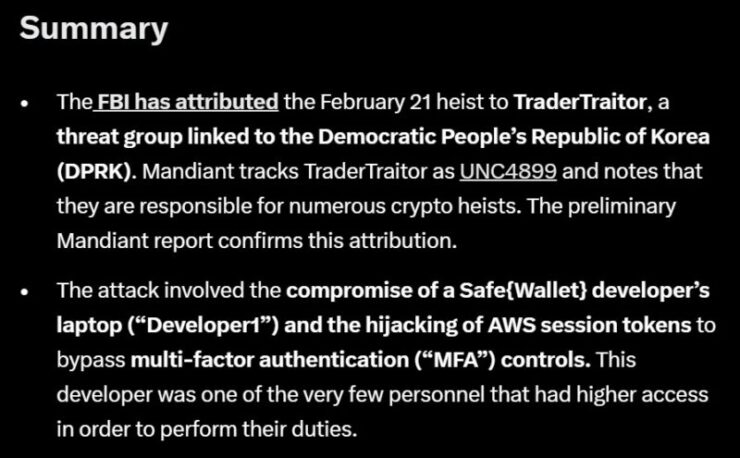A new investigation into the massive Ethereum hack on Bybit has revealed troubling details surrounding the incident, which saw the platform lose over $1.4 billion worth of assets last month. Multi-signature wallet provider Safe has confirmed that the breach originated from a compromised developer’s laptop. This shocking revelation adds a new direction and more complexity to the investigation, which has been underway since the hack first took place on the Dubai-based centralized exchange last month.
The hack, which saw a massive loss of Ethereum assets, was initially suspected to involve vulnerabilities in Bybit’s security systems. However, Safe, which was responsible for safeguarding a significant portion of the assets, now attributes the breach to a malicious code injection into its infrastructure. The injection, which was traced back to the compromised developer laptop, opened the door for attackers to siphon off billions in Ethereum. Safe, alongside security experts from Mandiant, released the findings, emphasizing that this breach had reached a critical checkpoint in the ongoing investigation.

How the Hack Unfolded from Safe’s Perspective
The hack began on February 4 when a high-level Safe developer’s workstation was compromised during an interaction with a malicious Docker project, a lightweight application often used to deploy software. This initial compromise allowed the hackers to bypass multi-factor authentication (MFA) protocols on Safe’s Amazon Web Services (AWS) account. Using hijacked AWS session tokens, the attackers gained unauthorized access to Safe’s systems. Two weeks later, malicious JavaScript was inserted into the Safe website, which facilitated the exploit on Bybit on February 21.
The FBI and on-chain investigators have linked the attack to North Korea’s Lazarus hacking group, which has been known for its involvement in large-scale cyberattacks targeting financial institutions. By leveraging sophisticated methods, including bypassing MFA, Lazarus was able to execute the attack with precision, contributing to one of the largest crypto thefts in recent memory.
In the aftermath of the hack, Safe has implemented several security upgrades to prevent further breaches. These include a complete reset of its infrastructure, a redesigned user interface (UI) to improve transaction hash verification, and enhanced detection mechanisms for malicious transactions. Despite these improvements, the investigation remains ongoing, with Safe urging users to become more vigilant in verifying the authenticity of transactions they approve or sign. Also, users have been less than impressed with this revelation from Safe, with many expressing their belief that this was some schoolboy error from the developer.
“Is it a joke that a developer with high privilege will run docker from a zip file, not pulling from docker hub or github? Just sounds like a bank accountant runs .EXE from an unknown source,” Said Moonchain developer, Sheenhuxin
“Ultimately, it was safe{wallet} UI that was compromised and the CTA with a lecture about verifying tx seems out of place. This wasn’t a noob not looking at what theyre signing situation,” 0xDjango added.
Bybit’s Response and Market Impact
The Bybit hack has been labeled the largest crypto hack of all time. Following the hack, Bybit took immediate steps to secure the remaining funds and alerted its user base. However, the damage was done. Ethereum’s price dipped in response as investors became wary of potential vulnerabilities in other major exchanges. The hack has put a spotlight on the increasing risks associated with centralized platforms, particularly when it comes to smart contract vulnerabilities. The crypto community is now urging exchanges to adopt more robust security frameworks to prevent future incidents.
Quick Facts:
- The $1.4 billion Ethereum hack was traced back to a compromised developer laptop, which allowed malicious code to infiltrate Safe’s infrastructure.
- Safe, in partnership with Mandiant, has reached a “critical checkpoint” in the investigation and is working towards further strengthening security protocols.
- The incident calls for the broader crypto community to learn from the hack and implement stronger defenses against similar threats.





